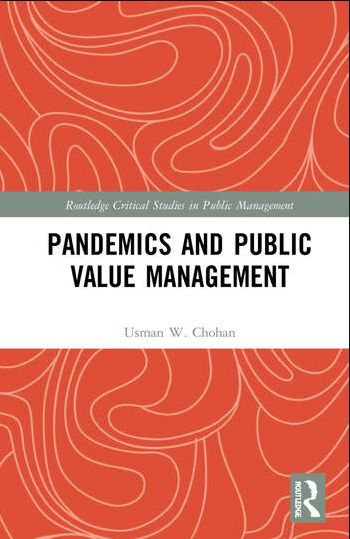Book Review
Usman W. Chohan, Pandemics and Public Value Management (New York & London: Routledge Taylor & Francis Group, 2022).
Reviewed by Shaza Arif
The onset of the COVID-19 Pandemic has transformed the world to a remarkable extent. Its impact will certainly be felt even when it becomes a fading memory. Among the many areas it has impacted, Public Value Management (PVM) is an intriguing case that needs to be analysed in depth through a multidimensional approach. The book ‘Pandemics and Public Value Management’, by Dr Usman W. Chohan, is a recent take on the concerned subject.
In 178 pages, the author draws attention to several aspects of PVM vis-à-vis COVID-19 through the lens of Public Value Theory (PVT). The book comprises six chapters. The introductory chapter provides an overview of public management with a focus on PVT and includes an overview of the book. In Chapter Two, Dr Chohan explores the lives versus livelihood dilemma vis-à-vis the Pandemic. Subsequently, in Chapter Three, he analyses the Pandemic in the context of misinformation in the post-truth era, and its implications on the health sector. The role of the World Health Organisation (WHO) is analysed in Chapter Four. After discussing the challenges confronted by the organisation, Dr Chohan applies the ‘Strategic Triangle’ to assess its limitations in performing optimally. This is followed by vaccine nationalism, discussed in Chapter Five. It highlights concerns about ‘vaccine nationalism’ as a socioeconomic problem. It also compares value preferences and conflicts at the national and international levels by listing cases for and against vaccine nationalism and proposes recommendations for value creation at the global level. This is followed by a comparative analysis of India-Pakistan in managing the Pandemic and thoughtful concluding chapter.
‘Pandemics and Public Value Management’ is an excellent, relevant, and timely contribution to public value literature. It adopts a pragmatic approach in analysing public values from multiple angles to help comprehend critical aspects of a global health crisis which is still part of our daily lives, even if not at the same level. The book not only explores the creation of public value but also studies how it can be weakened to underscore the broader dynamics of public management. While it is true that the subjects tackled in the book have repeatedly been discussed on multiple academic platforms, the book’s core strength is that it reveals underlying reasons in a structured manner to help the reader recognise ‘Why’ certain circumstances occurred the way they did during the Pandemic, and ‘How’ was public value perceived by concerned stakeholders.
The overall structure of the book and each chapter is well-organised. While the concepts listed in the initial chapters are applied in the succeeding parts to offer clearer understanding, the beauty of the book is that every chapter can be read independently to have fresh insights into the specific aspect. Tables and figures are useful and engaging. Concepts such as the Public Value Strategic Triangle (p.130), Triangle of Disvalue (p.66), Multiangle Triangle Approach (p.133), and their application were new for me, but their practical linkages helped in understanding them easily. The data and literature cited vividly demonstrates the research prowess of the author.
The contribution of the book in terms of policy-making deserves due appreciation. By comparing the cases of India and Pakistan vis-à-vis management of the pandemic in Chapter Six, Dr Chohan has validated the assertion that it is possible to balance lives and livelihoods, in contrast to choosing one over the other. For me, this section is the book’s most interesting chapter. The findings reveal that the concerned actors of public management can overcome the constraints of operational resources via value co-creation, as evident in Pakistan’s case of effectively managing the Pandemic. It highlights that collaborative and synchronised efforts of politicians, public managers, and civil society can lead to miraculously positive results. Hence, it can serve as a guiding light for policymakers in testing times. In addition, given the pace of the manifestation of the impacts of climate change, one cannot rule out the onset of more pandemics in the future. Hence, it would help concerned stakeholders to draw important lessons to tackle another potential pandemic and be well-prepared to counter threats such as misinformation and vaccine nationalism, both of which played a major role in worsening the pandemic situation, etc. The book should also be credited for identifying the existing constraints faced by the WHO. The pandemic should be a wake-up call for the international community to invest wisely and generously in the international organisation to increase its effectiveness.
The book is definitely worth the time and effort and is highly recommended reading. It would be helpful to policymakers around the world in articulating better policies in disruptive times; and equally important for concerned actors involved in PVM to understand the significance of the impact of their respective roles. It would also be of great use for the students of public management to have a more refined grasp of the various contours of their field.
Shaza Arif is a Research Assistant at the Centre for Aerospace & Security Studies (CASS), Islamabad, Pakistan. She can be reached at [email protected]





